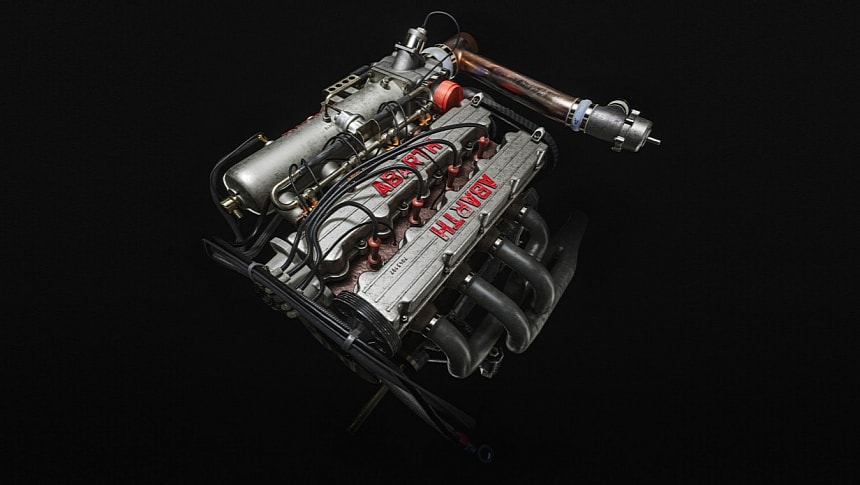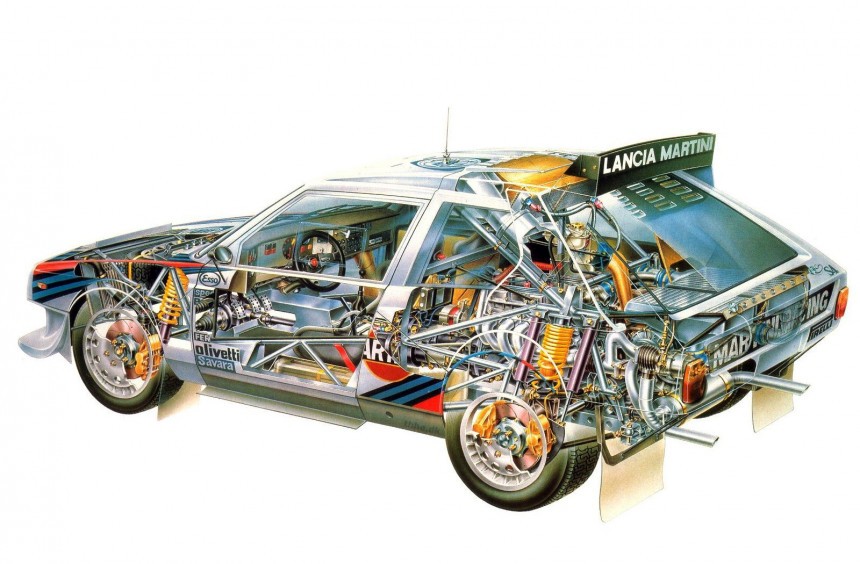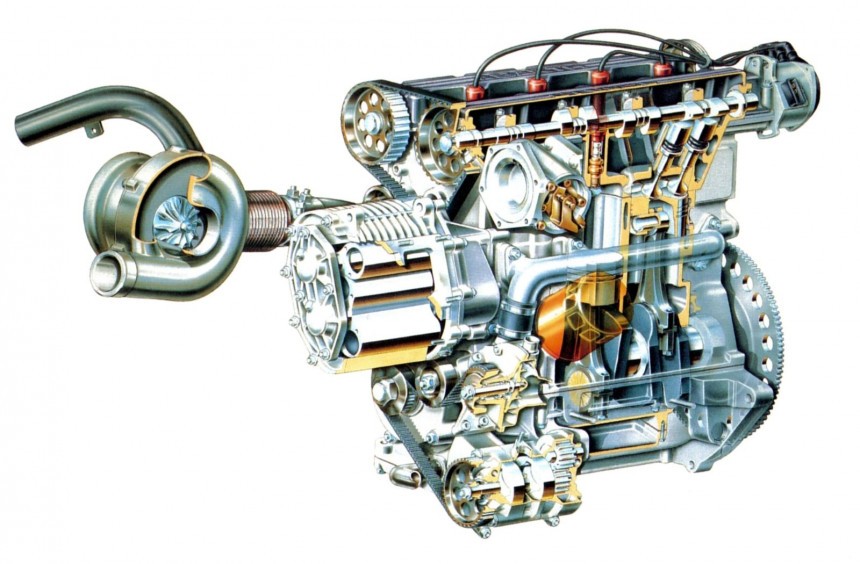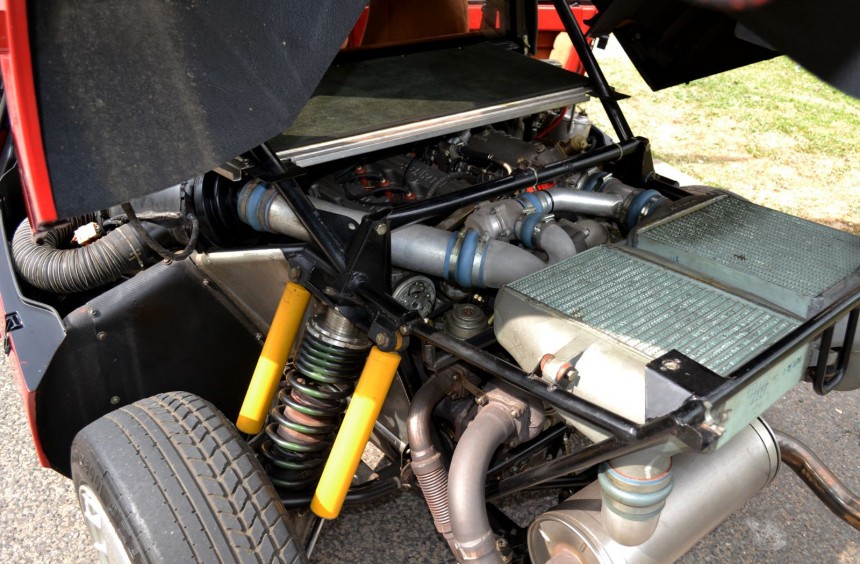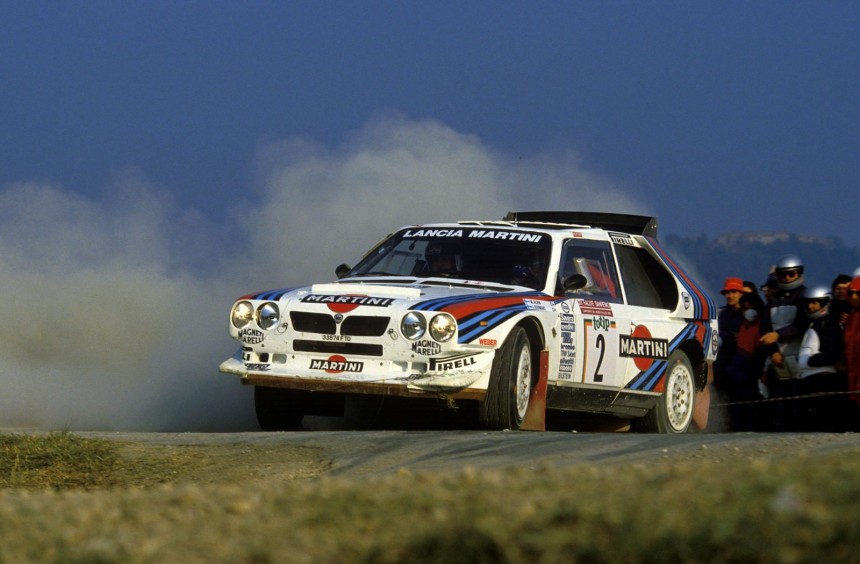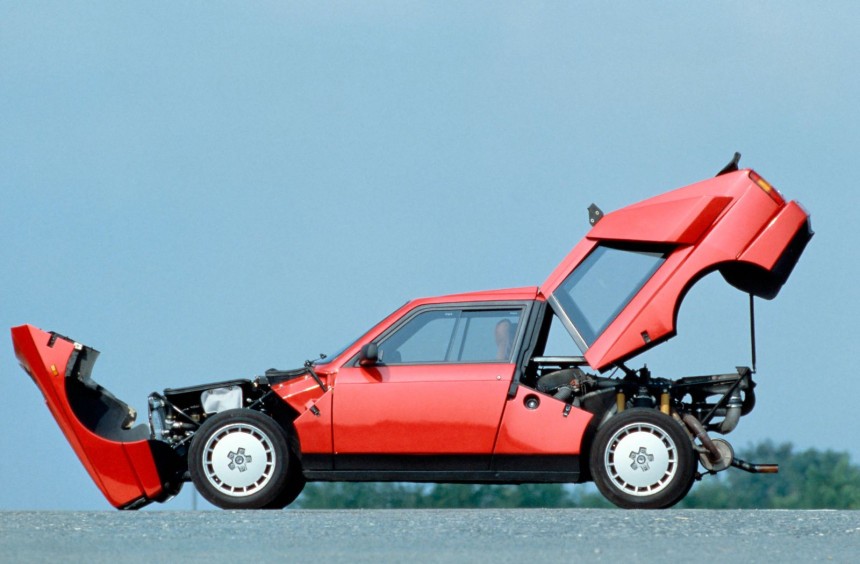In an era when forced induction was mandatory to be successful in motorsport, Lancia and Abarth created a monstrous 1,000-hp inline-four that eliminated the drawbacks of the turbocharger and the supercharger by combining the two.
Ever since the internal combustion engine became the norm in the automotive industry, engineers have pushed the envelope of performance, mainly in through the world of motorsport.
For decades, this was done by increasing the number of cylinders and/or displacement. However, with the arrival of the supercharger and turbocharger, mainly from the 1930s onwards, forced induction was added to the list of power-increasing methods.
The supercharger, a mechanical device that pushes more air into the combustion chamber, was the preferred forced induction alternative for many years, but starting with the 1970s, the advancements in turbocharger technology started balancing the scales.
A decade later, the turbo, which uses kinetic energy produced by the exhaust gasses to produce compressed air and force it into the chambers, became the go-to method of increasing engine output, mainly in race engine.
But, while more efficient than the supercharger, the turbo had one major drawback known as turbo lag.
On the other hand, the supercharger also had its disadvantages, such as decreased efficiency (in terms of power potential vs a turbo), higher fuel consumption, and increased weight.
Therefore, during the 1980s, many engineers became obsessed with eliminating the disadvantages of both devices, and the joint team of Lancia and Abarth managed to cleverly solve most of the issues by combining the two devices.
By 1981, Fiat, the Italian automotive conglomerate that owned Lancia, Abarth, and other of the country's famous automotive brands, was a dominant force in the World Rally Championship (WRC).
It won the revised competition's debut season in 1977 with the Lancia Stratos, then grabbed two more titles in 1978 and 1980 with the Abarth-tuned Fiat 131.
For the 1982 season the corporation's WRC efforts were again focused on the Lancia brand, which joined forces with the engineering experts at Abarth to create a new mid-engine Group B contender called Lancia 037.
Powered by a supercharged inline-four, the 037 was Fiat's main rally weapon for four seasons, but the car only managed to bring home one manufacturer's trophy in 1983.
Struggling to keep up with Audi's revolutionary 4WD Quattro and threatened by Peugeot's all-new 205 Turbo 16, the Italians went back to the drawing board in 1984 and created an all-new Grout B contender.
Dubbed Delta S4, the new car featured a solid 4WD system, but more impressively, it came with arguably the most advanced race engine of the era, a twincharged inline-four capable of jaw-dropping performance.
During the exciting golden era of Group B rallying, innovation was the name of the game.
With the 4WD issue set to be solved with help from English company Hewland, Lancia and Abarth focused on the development of a new engine that would give the new Delta S4 the edge against its main rivals.
The Abarth engineers, who were in charge of the project, decided to reduce the displacement of the existing Lampredi (Twin-Cam) Fiat engine - which also reduced the car's overall weight restriction - and redesign its forced induction system.
Rather than relying solely on the previously used supercharger or replacing it with a big turbo, the team opted to combine the two.
Though not new, the idea of combining a turbo and a supercharger (twincharging) was never successfully implemented in a production engine, let alone one that could cope with the rigors of motorsport.
Determined to eliminate the low-rpm deficiency of the era's turbocharger, but also take advantage of its the ample boost in the high-rpm range, the engineers managed to beat the odds and create the world's first viable twincharged production engine.
They devised a system that used a Volumex supercharger at low-to-mid rpm operation, then passed the forced induction torch to a Kühnle, Kopp & Kausch (KK&K) turbocharger that kicked in to provide boost for the 1.8-liter from the 4,500 rpm threshold to its 8,000 rpm limit.
Simple in theory but extremely hard to put together in a reliable package, the innovative technology relied on a cleverly designed system comprised of pneumatic actuators and release valves.
Around 4,500 rpm, the system rerouted compressed air from the supercharger to spool up the turbo, which took over, eliminating both the low-rpm deficiency of the KK&K turbo and the lackluster high-rpm boost potential of the Volumex supercharger.
On the test bank, engineers managed to push the twincharged four-cylinder up to an whopping 1,000 hp by turning up the turbo boost pressure to 5 bar (72 PSI).
However, to improve long-term reliability, boost pressure was set much lower, resulting in a competition setup that delivered between 480 and 290 hp.
Once the engine and 4WD systems were developed, Lancia engineers took the 037's Chromoly steel chassis, upgraded it, and started designing a new body.
With the mid-mounted Lampredi displacing only 1.8 liters, the car had to abide by the 2,500 cc-class regulations, which allowed for a minimum weight of 890 kg (1,962 lb).
The weight limit enabled the engineers to create a much lighter car than the now-obsolete RWD 037. However, with the addition of the 4WD system, twincharging, and the complex cooling system, they had to shed pounds off the bodywork.
Though it shared the front fascia windshield and, eventually, the name with the series production Delta hatchback, the S4's body was designed from scratch.
To keep the weight down, most of the panels were fabricated from an extremely thin carbon-kevlar composite. This helped shed the required weight but provided little protection for the occupants, even with the integrated roll cage.
The S4 made its competition debut with a win at the Lombard RAC Rally, the last event on the 1985 calendar, and returned with another win in the 1986 season's opening round, the Monte Carlo Rally.
Extremely light but also extremely powerful and hard to tame, the Delta S4 was involved in several accidents, the most serious of which killed factory driver Henri Toivonen and co-pilot Sergio Cresto.
Blaming the engineers complete desregard for safety, the FIA decided to abolish the Group B after the 1986 season, and the Delta S4's WRC career was cut short.
To homologate the Delta S4 for WRC, Lancia had to build a minimum of 200 units of an identical road-legal version.
Dubbed S4 Stradale, the homologation special was produced from 1985 to 1986 and althoug Lancia gained WRC homologation, citing it had completed 200 units, it's believed that only 80 to 90 Stradales were actually built.
Donning fiberglass bodies, these cars were powered by the same Lampredi engine, albeit with a smaller turbocharger and a reduced compression ratio that led to an output of 247 hp.
Though seriously limited in terms of output, the 1.8-liter officially became the world's first twincharged production engine with the introduction of the Stradale.
Today, the Tipo 233 ATR 18S remains one of the most fascinating engines ever built and probably the most advanced race engine produced during the 1980s.
Twincharging was adapted to future production engines, and although it never became the most popular forced induction system, it was used on several high-volume powerplants, most notably the VW Group's 1.4-liter TSI inline-four.
For more on this fascinating Italian race engine, we recommend watching the YouTube video below by 337 SPEED.
For decades, this was done by increasing the number of cylinders and/or displacement. However, with the arrival of the supercharger and turbocharger, mainly from the 1930s onwards, forced induction was added to the list of power-increasing methods.
The supercharger, a mechanical device that pushes more air into the combustion chamber, was the preferred forced induction alternative for many years, but starting with the 1970s, the advancements in turbocharger technology started balancing the scales.
A decade later, the turbo, which uses kinetic energy produced by the exhaust gasses to produce compressed air and force it into the chambers, became the go-to method of increasing engine output, mainly in race engine.
But, while more efficient than the supercharger, the turbo had one major drawback known as turbo lag.
On the other hand, the supercharger also had its disadvantages, such as decreased efficiency (in terms of power potential vs a turbo), higher fuel consumption, and increased weight.
Therefore, during the 1980s, many engineers became obsessed with eliminating the disadvantages of both devices, and the joint team of Lancia and Abarth managed to cleverly solve most of the issues by combining the two devices.
Created during the most competitive period in the history of rallying
It won the revised competition's debut season in 1977 with the Lancia Stratos, then grabbed two more titles in 1978 and 1980 with the Abarth-tuned Fiat 131.
For the 1982 season the corporation's WRC efforts were again focused on the Lancia brand, which joined forces with the engineering experts at Abarth to create a new mid-engine Group B contender called Lancia 037.
Powered by a supercharged inline-four, the 037 was Fiat's main rally weapon for four seasons, but the car only managed to bring home one manufacturer's trophy in 1983.
Struggling to keep up with Audi's revolutionary 4WD Quattro and threatened by Peugeot's all-new 205 Turbo 16, the Italians went back to the drawing board in 1984 and created an all-new Grout B contender.
The most advanced engine of its era
During the exciting golden era of Group B rallying, innovation was the name of the game.
With the 4WD issue set to be solved with help from English company Hewland, Lancia and Abarth focused on the development of a new engine that would give the new Delta S4 the edge against its main rivals.
The Abarth engineers, who were in charge of the project, decided to reduce the displacement of the existing Lampredi (Twin-Cam) Fiat engine - which also reduced the car's overall weight restriction - and redesign its forced induction system.
Rather than relying solely on the previously used supercharger or replacing it with a big turbo, the team opted to combine the two.
Pushing the envelope of innovation to a whole new level
Determined to eliminate the low-rpm deficiency of the era's turbocharger, but also take advantage of its the ample boost in the high-rpm range, the engineers managed to beat the odds and create the world's first viable twincharged production engine.
They devised a system that used a Volumex supercharger at low-to-mid rpm operation, then passed the forced induction torch to a Kühnle, Kopp & Kausch (KK&K) turbocharger that kicked in to provide boost for the 1.8-liter from the 4,500 rpm threshold to its 8,000 rpm limit.
Simple in theory but extremely hard to put together in a reliable package, the innovative technology relied on a cleverly designed system comprised of pneumatic actuators and release valves.
Around 4,500 rpm, the system rerouted compressed air from the supercharger to spool up the turbo, which took over, eliminating both the low-rpm deficiency of the KK&K turbo and the lackluster high-rpm boost potential of the Volumex supercharger.
On the test bank, engineers managed to push the twincharged four-cylinder up to an whopping 1,000 hp by turning up the turbo boost pressure to 5 bar (72 PSI).
However, to improve long-term reliability, boost pressure was set much lower, resulting in a competition setup that delivered between 480 and 290 hp.
Powering the most dangerous rally car ever created
With the mid-mounted Lampredi displacing only 1.8 liters, the car had to abide by the 2,500 cc-class regulations, which allowed for a minimum weight of 890 kg (1,962 lb).
The weight limit enabled the engineers to create a much lighter car than the now-obsolete RWD 037. However, with the addition of the 4WD system, twincharging, and the complex cooling system, they had to shed pounds off the bodywork.
Though it shared the front fascia windshield and, eventually, the name with the series production Delta hatchback, the S4's body was designed from scratch.
To keep the weight down, most of the panels were fabricated from an extremely thin carbon-kevlar composite. This helped shed the required weight but provided little protection for the occupants, even with the integrated roll cage.
The S4 made its competition debut with a win at the Lombard RAC Rally, the last event on the 1985 calendar, and returned with another win in the 1986 season's opening round, the Monte Carlo Rally.
Extremely light but also extremely powerful and hard to tame, the Delta S4 was involved in several accidents, the most serious of which killed factory driver Henri Toivonen and co-pilot Sergio Cresto.
Blaming the engineers complete desregard for safety, the FIA decided to abolish the Group B after the 1986 season, and the Delta S4's WRC career was cut short.
The world's first twincharged production engine
Dubbed S4 Stradale, the homologation special was produced from 1985 to 1986 and althoug Lancia gained WRC homologation, citing it had completed 200 units, it's believed that only 80 to 90 Stradales were actually built.
Donning fiberglass bodies, these cars were powered by the same Lampredi engine, albeit with a smaller turbocharger and a reduced compression ratio that led to an output of 247 hp.
Though seriously limited in terms of output, the 1.8-liter officially became the world's first twincharged production engine with the introduction of the Stradale.
Today, the Tipo 233 ATR 18S remains one of the most fascinating engines ever built and probably the most advanced race engine produced during the 1980s.
Twincharging was adapted to future production engines, and although it never became the most popular forced induction system, it was used on several high-volume powerplants, most notably the VW Group's 1.4-liter TSI inline-four.
For more on this fascinating Italian race engine, we recommend watching the YouTube video below by 337 SPEED.
